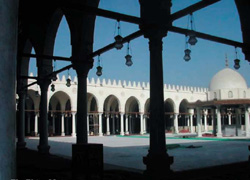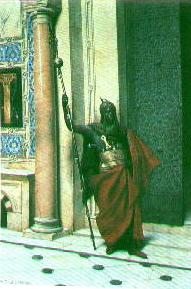

To next page
Nasir-I Khusraw: Safar-nama (Book of Travels)
1052 (from Persia; Marv)
--------------------------------------------------
Taken from: Nasir -I Khusraw : Safar-nama
Also called Naser-e Khosrah
They say no one has been able to ascertain the source of the Nile, and I heard that the Sultan of Egypt sent some people who went along the Nile banks for a year investigating but were unable to discover the source. It is said however that it comes from a mountain in the south called Jabal al-Qamar (mountain of the moon)
....Following the coastline from Jar, you will come to the Yemen and the coast of Aden; continuing in that direction, you will eventually wind up in India and China. Continuing southwards from Aden and slightly westward, you will come to Zanzibar and Ethiopia, which will be described presently. Going south from Egypt through Nubia, you come to the province of the Masmudis, which is a land of broad pasturelands, many animals, and heavy set, strong-limbed, squat, black skinned men, there are many soldiers of this sort in Egypt....
Note: this and some remarks from Ibn Battuta, give evidence of East-Africans as man of arms, worldwide, not as slaves, but as highly paid volunteers.

Note that this was (until the translation of Albiruni's stonebook) the only mention we had in literature that crystal (as attested through archeology) was exported from east Africa.
The town of Aydhab is situated by the sea and has a Friday mosque and a population of five hundred. It belongs to the Sultan of Egypt and is a customs station for ships coming from Abyssinia, Zanzibar, and the Yemen. From there goods are transported by camel across the dessert, the same way we had come, to Aswan and thence by boat to Cairo.
To reach the town of Lahsa from any direction, you have to cross vast expanses of desert. The nearest Muslim city to Lahsa that has a ruler is Basra.....
At the time I was there they had thirty thousand Zanzibari and Abyssinian slaves working in the fields and gardens.
------------------------------------------------------------------------------------------------------------------------
Nasir i Khusraw from his Divan in a qasidah (long poem)
Taken from: Minoo Southgate: The negative Images of Blacks In some Medieval Iranian Writings. In : Iranian studies 1984
Why was the Muslim given mastery over the Hindu and the Zanj? This was his reward for his religious superiority over the Hindu and the Zanj, for which distinction he owes God many thanks.
Night is personified as an old and ugly (na�khub-i pir) Zangi who gives birth to a handsome Anatolian slave boy.
He also complains about evil sounding Zangis (crows) putting to flight a host of nightingales.
He compares the world as a two faced sorceress who appears as a Rumi (good) or as a Zangi (evil)